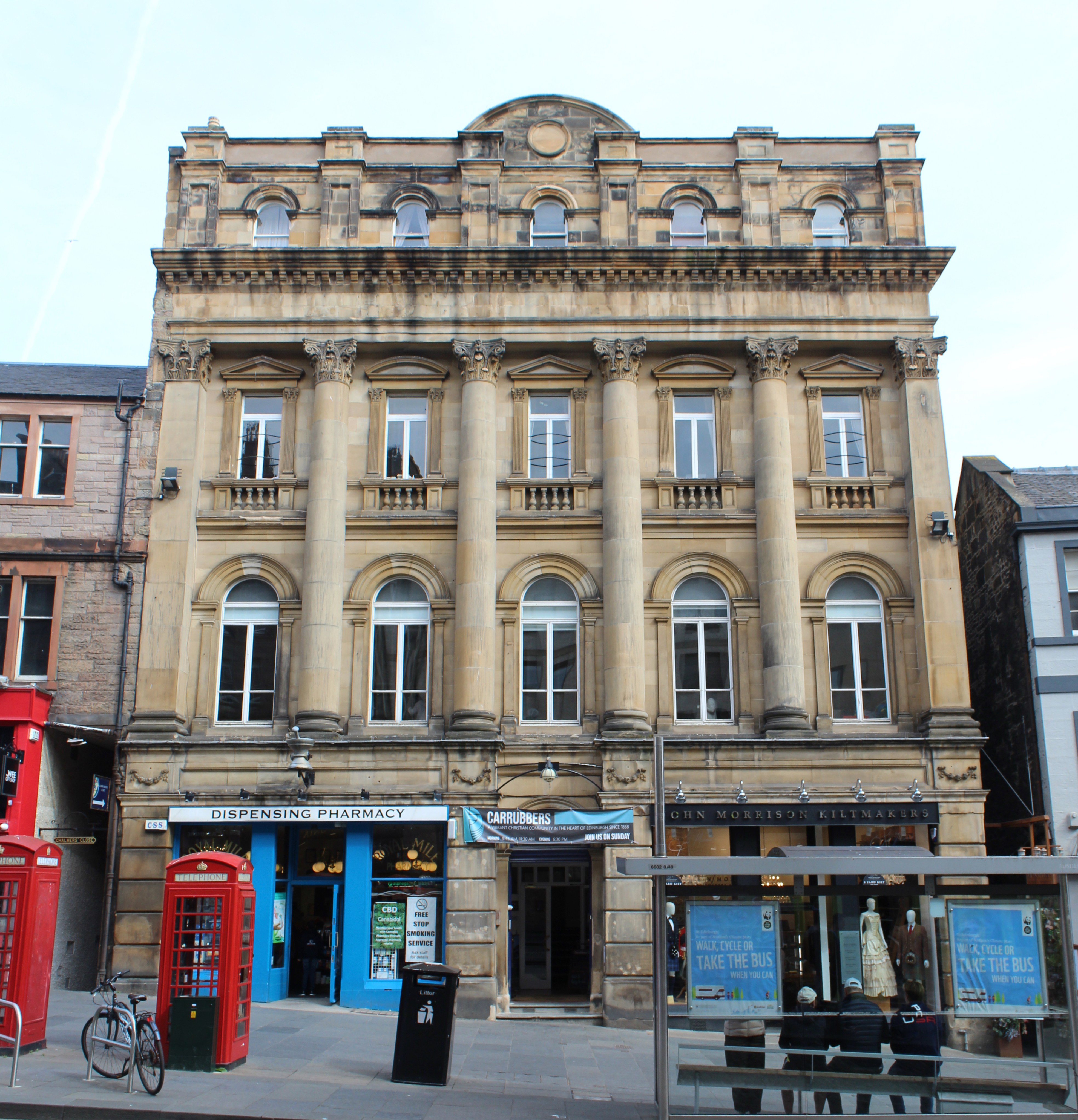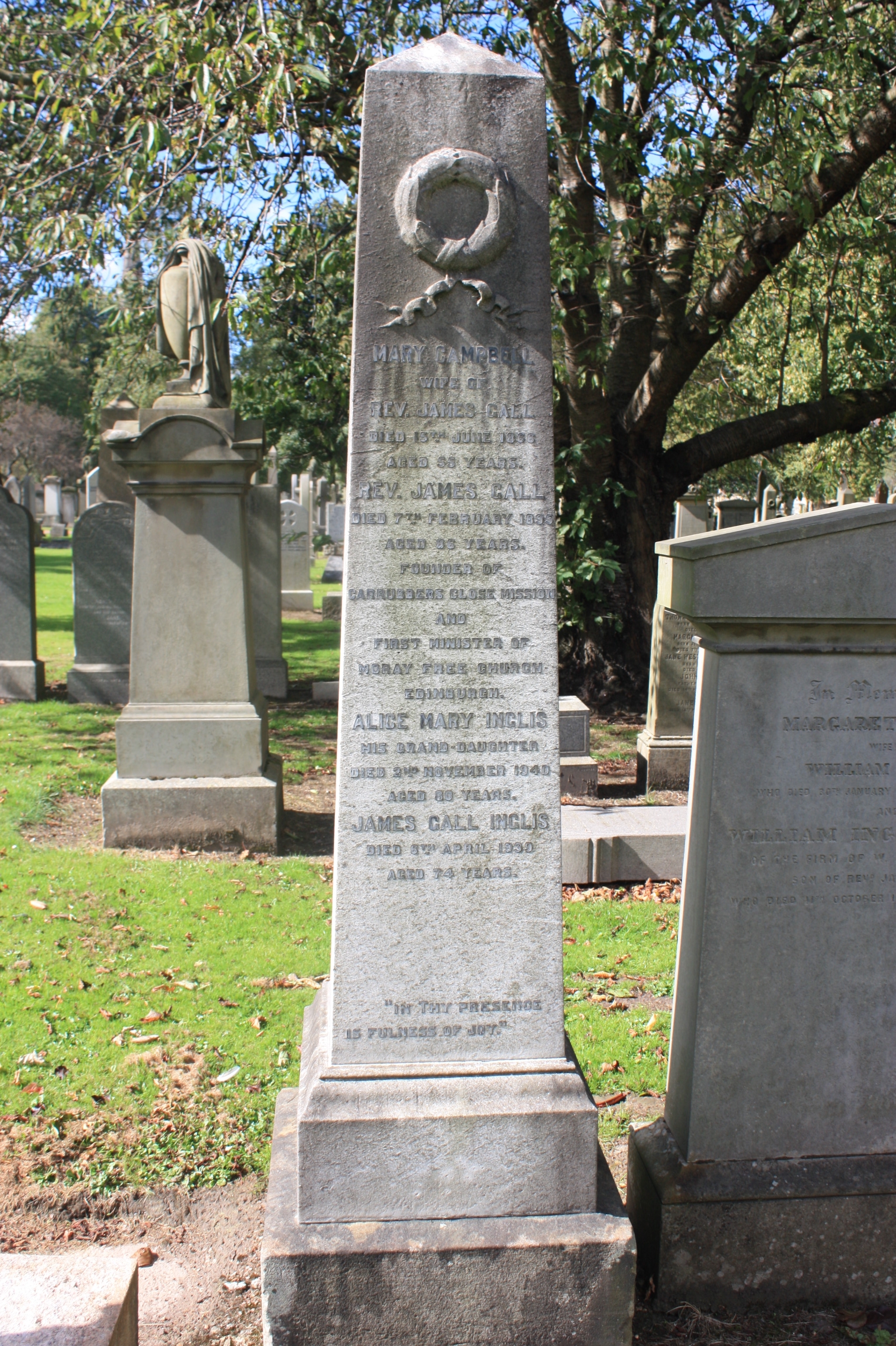James Gall on:
[Wikipedia]
[Google]
[Amazon]



 James Gall (27 September 1808 – 7 February 1895) was a Scottish
James Gall (27 September 1808 – 7 February 1895) was a Scottish
Primeeval Man Unveiled: or The Anthropology of the Bible
' *''The Science of Missions'' *
The Synagogue as the Model of the Christian Church
' *''Catechism of Christian Baptism'' *''Dipping not Baptism'' *''Evangelistic Baptism'' *''Good Friday: A Chronological Mistake'' *''Home Missions: The People's Work'' *''Revival of Pentecostal Christianity'' *''Where the Morisonians Are Wrong''
Astronomical Publishing in Edinburgh in the 19th Century
(implies he founded "Carrubbers Close Mission" after 1874)
Carrubbers Close Mission History
at carrubbers.org (does not mention James Gall and states founded in 1858)
''Map Projections—A Working Manual: U.S. Geological Survey Professional Paper 1395''
Washington: Government Printing Office. {{DEFAULTSORT:Gall, James 1808 births 1895 deaths Scientists from Edinburgh Alumni of New College, Edinburgh Scottish cartographers Clergy from Edinburgh Scottish religious writers People educated at the Royal High School, Edinburgh



clergyman
Clergy are formal leaders within established religions. Their roles and functions vary in different religious traditions, but usually involve presiding over specific rituals and teaching their religion's doctrines and practices. Some of the ter ...
who founded the Carrubbers Close Mission. He was also a cartographer, publisher, sculptor, astronomer and author. In cartography he gives his name to three different map projections: Gall stereographic; Gall isographic; and Gall orthographic (Gall–Peters projection).
Life
Gall was born on 27 September 1808, the son of Ann Collie and James Gall, a printer who founded the printing company of Gall & Inglis in Edinburgh, which specialised in easy-access astronomy. His uncle, John Gall, ran a coach-building business. He was baptised atSt Cuthbert's Church, Edinburgh
The Parish Church of St Cuthbert is a parish church of the Church of Scotland in central Edinburgh. Probably founded in the 7th century, the church once covered an extensive parish around the burgh of Edinburgh. The church's current building was ...
on 15 October 1808.He lived with his family at Potterrow on the South Side of Edinburgh.
He was educated at the High School
A secondary school describes an institution that provides secondary education and also usually includes the building where this takes place. Some secondary schools provide both '' lower secondary education'' (ages 11 to 14) and ''upper seconda ...
close to his home and at the Trustees Academy. He was then apprenticed as a printer in his father's firm from 1822 before studying at the University of Edinburgh
The University of Edinburgh ( sco, University o Edinburgh, gd, Oilthigh Dhùn Èideann; abbreviated as ''Edin.'' in post-nominals) is a public research university based in Edinburgh, Scotland. Granted a royal charter by King James VI in 15 ...
. From 1838 he became a partner in his father's publishing firm, which specialised in maps.
In 1849, aged 41, he decided to retrain as a Free Church minister and studied at New College, Edinburgh
New College is a historic building at the University of Edinburgh which houses the university's School of Divinity. It is one of the largest and most renowned centres for studies in Theology and Religious Studies in the United Kingdom. Student ...
graduating in 1855. His first role was in the establishment of a mission at Carrubbers Close on the Royal Mile
The Royal Mile () is a succession of streets forming the main thoroughfare of the Old Town of the city of Edinburgh in Scotland. The term was first used descriptively in W. M. Gilbert's ''Edinburgh in the Nineteenth Century'' (1901), des ...
.Ewing, William ''Annals of the Free Church''
At this time he was still a partner in Gall & Inglis. He was living at Myrtle Bank in Trinity, Edinburgh
Trinity is a district of northern Edinburgh, Scotland, once a part of the burgh of Leith (itself a part of the city since 1920). It is one of the outer villa suburbs of Edinburgh mainly created in the 19th century. It is bordered by Wardie to ...
.
In 1858 he was chosen to minister at the new Free Church in the Canongate
The Canongate is a street and associated district in central Edinburgh, the capital city of Scotland. The street forms the main eastern length of the Royal Mile while the district is the main eastern section of Edinburgh's Old Town. It began ...
, holding the overspill from the growing mission work at Carrubbers Close. This originally held services in a hall at Moray House until a building was completed in 1862. This stood on Holyrood Road on the Site now occupied by the main Moray College building. It was later named the Moray Free Church. He lived adjacent to the church at 10 St John Street. He resigned from the church in 1872 to concentrate on mission work. His place at the Moray Church was filled by Rev Walter Glendinning. He lost his manse at John Street as a result of this decision, and lived for a while thereafter at a flat at 47 Forrest Road.
He died at home, 35 Newington Road in Edinburgh on 7 February 1895. He is buried in the north-east section of Grange Cemetery
The Grange (originally St Giles' Grange) is an affluent suburb of Edinburgh, just south of the city centre, with Morningside and Greenhill to the west, Newington to the east, The Meadows park and Marchmont to the north, and Blackford Hil ...
in Edinburgh, nearby his father. His funeral took place on 11 February 1895 and was attended by over 600 of his many admirers.
Religious views
Most of Gall's work on religion was detailed in a book called ''The Stars and the Angels,'' (1858) in which he not only argues for the existence of other inhabitedplanet
A planet is a large, rounded astronomical body that is neither a star nor its remnant. The best available theory of planet formation is the nebular hypothesis, which posits that an interstellar cloud collapses out of a nebula to create a you ...
s, but describes the view that Gabriel
In Abrahamic religions (Judaism, Christianity and Islam), Gabriel (); Greek: grc, Γαβριήλ, translit=Gabriḗl, label=none; Latin: ''Gabriel''; Coptic: cop, Ⲅⲁⲃⲣⲓⲏⲗ, translit=Gabriêl, label=none; Amharic: am, ገብር� ...
would have had on his way from heaven to earth to tell Mary
Mary may refer to:
People
* Mary (name), a feminine given name (includes a list of people with the name)
Religious contexts
* New Testament people named Mary, overview article linking to many of those below
* Mary, mother of Jesus, also calle ...
that she would have a baby next Christmas
Christmas is an annual festival commemorating Nativity of Jesus, the birth of Jesus, Jesus Christ, observed primarily on December 25 as a religious and cultural celebration among billions of people Observance of Christmas by country, around t ...
.
A rare, but important, work by Gall is ''The Synagogue Not the Temple, the Germ and Model of the Christian Church'', published in 1890. It discusses the foundation upon which the Christian Church is modelled.
Gall in ''Primeeval Man Unveiled: or The Anthropology of the Bible,'' writes that " e Bible narrative does not commence with creation, as is commonly supposed, but with the formation of Adam and Eve, millions of years after our planet had been created. Its previous history, so far as Scripture is concerned, is yet unwritten. There may have been not one, but twenty different races upon the earth before the time of Adam, just as there may be twenty different races of men on other worlds ... "
Astronomy
Gall's main work as an astronomer was with the constellations. As part of this work he developed the Gall orthographic projection, a derivative of theLambert cylindrical equal-area projection
In cartography, the Lambert cylindrical equal-area projection, or Lambert cylindrical projection, is a
cylindrical equal-area projection. This projection is undistorted along the equator, which is its standard parallel, but distortion increase ...
, to project the celestial sphere onto flat paper in a manner that avoided distorting the shapes of the constellations. He also applied this technique to terrestrial mapmaking as a way to make a flat map of the round Earth. Gall Orthographic was re-invented by Arno Peters
Arno Peters (22 May 1916 – 2 December 2002) was a German historian who developed the Peters world map, based on the Gall–Peters projection.
Biography
Peters was born in Berlin. In childhood he lived in Berlin, Germany, with his brother, Wern ...
in 1967 and adopted by organisations such as UNESCO
The United Nations Educational, Scientific and Cultural Organization is a specialized agency of the United Nations (UN) aimed at promoting world peace and security through international cooperation in education, arts, sciences and culture. It ...
. In recognition of both men the form is now called the Gall-Peters projection.
Gall himself was an advocate of accessible mapping for blind people. One format he suggested was to combine Braille printing with twine to indicate lines. An 1851 book included such a map by Gall and his partner Inglis. It used raised borders to indicate county boundaries and other features.
Publications
*''Easy Guide to the Constellations'' (1870) *''People's Atlas of the Stars'' *''Handbook to Astronomy'' *''Use of Cylindrical Projections for Geographical, Astronomical and Scientific Purposes'' (1885) *Primeeval Man Unveiled: or The Anthropology of the Bible
' *''The Science of Missions'' *
The Synagogue as the Model of the Christian Church
' *''Catechism of Christian Baptism'' *''Dipping not Baptism'' *''Evangelistic Baptism'' *''Good Friday: A Chronological Mistake'' *''Home Missions: The People's Work'' *''Revival of Pentecostal Christianity'' *''Where the Morisonians Are Wrong''
Family
Gall's father, James Gall (1784–1874), designed a "triangular alphabet" used for embossed books for blind people and was instrumental.in founding the Royal Blind School in Edinburgh. He was also the principal creator of the Scottish Sunday School system. In 1833 Gall married Mary Campbell fromBelfast
Belfast ( , ; from ga, Béal Feirste , meaning 'mouth of the sand-bank ford') is the capital and largest city of Northern Ireland, standing on the banks of the River Lagan on the east coast. It is the 12th-largest city in the United Kingdo ...
(1810-1866). Their eldest son, James Gall (b.1834) became a businessman in Jamaica
Jamaica (; ) is an island country situated in the Caribbean Sea. Spanning in area, it is the third-largest island of the Greater Antilles and the Caribbean (after Cuba and Hispaniola). Jamaica lies about south of Cuba, and west of His ...
. Their daughter, Elizabeth ("Eliza") Walkingshaw Gall (1835-1912), married Robert Inglis, the son of James Gall's business partner, who then inherited the printing company of Gall & Inglis on James's death. Robert's son, James Gall Inglis FRSE
Fellowship of the Royal Society of Edinburgh (FRSE) is an award granted to individuals that the Royal Society of Edinburgh, Scotland's national academy of science and letters, judged to be "eminently distinguished in their subject". This soci ...
(1865–1939) was also a keen astronomer and came to the firm in 1880. He is buried with James Gall. Anna Gall (1838-1929) died a spinster.
References
Astronomical Publishing in Edinburgh in the 19th Century
(implies he founded "Carrubbers Close Mission" after 1874)
Carrubbers Close Mission History
at carrubbers.org (does not mention James Gall and states founded in 1858)
Further reading
* James P. Snyder (1987)''Map Projections—A Working Manual: U.S. Geological Survey Professional Paper 1395''
Washington: Government Printing Office. {{DEFAULTSORT:Gall, James 1808 births 1895 deaths Scientists from Edinburgh Alumni of New College, Edinburgh Scottish cartographers Clergy from Edinburgh Scottish religious writers People educated at the Royal High School, Edinburgh